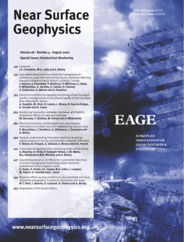-
oa Time‐intensive geoelectrical monitoring under winter wheat
- Source: Near Surface Geophysics, Volume 18, Issue Geoelectrical Monitoring, Jul 2020, p. 413 - 425
-
- 21 Jan 2020
- 11 May 2020
- 07 Jun 2020
Abstract
Several studies have explored the potential of electrical resistivity tomography to monitor changes in soil moisture associated with the root water uptake of different crops. Such studies usually use a set of limited below‐ground measurements throughout the growth season but are often unable to get a complete picture of the dynamics of the processes. With the development of high‐throughput phenotyping platforms, we now have the capability to collect more frequent above‐ground measurements, such as canopy cover, enabling the comparison with below‐ground data. In this study hourly direct‐current resistivity data were collected under the Field Scanalyzer platform at Rothamsted Research with different winter wheat varieties and nitrogen treatments in 2018 and 2019. Results from both years demonstrate the importance of applying the temperature correction to interpret hourly electrical conductivity data. Crops which received larger amounts of nitrogen showed larger canopy cover and more rapid changes in electrical conductivity, especially during large rainfall events. The varieties showed contrasted heights although this does not appear to have influenced electrical conductivity dynamics. The daily cyclic component of the electrical conductivity signal was extracted by decomposing the time series. A shift in this daily component was observed during the growth season. For crops with appreciable difference in canopy cover, high‐frequency direct‐current resistivity monitoring was able to distinguish the different below‐ground behaviours. The results also highlight how coarse temporal sampling may affect interpretation of resistivity data from crop monitoring studies.




